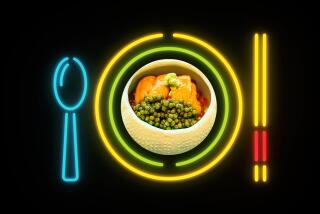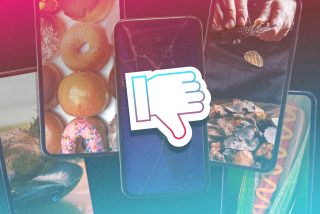ON THE TABLE : The Scorched-Food Policy
- Share via
There are times when I think that the single best dish in the world is good cheese melted and then seriously browned on top of good toasted bread. There are times when there is literally nothing I’d rather eat. The aroma is irresistible; the textural contrast of earthy crunch and creamy richness, sublime; the flavor, immensely satisfying.
Even the cheese’s temperature is attractive if you eat the preparation quickly enough--just barely on the safe side of molten, and thus an evoker of frisson . If cheese in general is, as Clifton Fadiman once proposed, “milk’s leap toward immortality,” then cheese in this form is milk that has actually gotten there.
What makes cheese browned on toasted bread so good? Simple: It’s burnt. This doesn’t mean that it’s incinerated. But it has been changed mightily in physical form, and thus in gustatory effect, by heat.
The application of heat to cheese must be done with a certain intuitive precision, of course; this is not a dish to be timed to the second, but it is one whose presence under the broiler must be remembered just in time. Burning can go too far. Nothing tastes much good if it has reached the point of being ashen.
But charred is a friend. Think of all the good burnt foods (or parts of foods) there are: Think of the skin on the top and the crust underneath an old-fashioned rice pudding; the deep-brown crust or socarrat on the bottom of a properly made paella; the faint black cast atop the best floury wood-oven bread in Italy or France (or in the genuine Italian or French style); the skin of pungent herbs and spices seared onto fillets of properly made Cajun-style fish; the handsome, glistening black shell of flavor on a charcoal-grilled hamburger or steak. Think of burnt ends--those crispy, jet-black shreds and shards of meat cut or pulled from larger pieces of slow-cooked beef or pork at the best barbecue emporiums. Think of coffee and cocoa, for heaven’s sake, which would just be bitter greenish beans if they weren’t burned first.
Burning food is even part of one of the fundamental processes of classical French cooking: Every time a recipe asks you to deglaze a pan, it is in effect directing you to incorporate into an added liquid all the highly flavorful bits of whatever you’ve been cooking that have burned themselves onto the bottom of the vessel.
Why is burnt food so satisfying? I suspect that there are psychological reasons, to begin with: It tends to look good--golden darkening to brown in color, glistening, basic. And burnt food seems finished, matured, ready; it isn’t raw; it is food realized, not just potential. There’s probably something in there too about primeval memories of our cave-dwelling ancestors roasting tiger bones on lightning-kindled fires--but let’s not get silly about this.
The appeal of burnt food can be explained much more rationally too. The application of heat to food has a number of physical consequences, one of which is the so-called Maillard Reaction--named for the early 20th-Century French biochemist Louis-Camille Maillard, who first observed, in experiments at the University of Nancy, that sugars and amino acids (both of which most foods contain) turn brown when heated together. All manner of complex flavor and aroma molecules, it has since been discovered, are generated in the process. (Maillard himself, it might be noted, quickly grew bored with the subject and ended his days at the University of Algiers, studying the composition of urine.)
Burning food evokes something primordial not just in us but in the food as well. By burning it, we’re extracting its essence, bringing its carbon-black soul to the surface--carbon, after all, being the element common to all organic things.
Having said all this, I must now add that burnt food isn’t very good for you. I’ll wager that there are those reading this article at this very moment, in fact, in absolute horror. Celebrate the consumption of burnt food? they’re probably asking. May as well encourage the juggling of razor-sharp scimitars or the taking of afternoon naps on Pacific Coast Highway! And the truth is, I must admit, that the scientific community seems to universally agree that burning food--in addition to making it taste good--also produces in it compounds known to be carcinogenic and mutagenic. A single large charred steak, for instance, has been shown to contain the same amount of benzopyrene, a known carcinogen in animals, as several hundred cigarettes.
But, then, almost every foodstuff known to humankind contains some elements that are deleterious in large doses. (Among potential culprits recently identified as potentially dangerous are such seemingly innocuous foods as peanuts, mustard, basil and black pepper!) The obvious trick, then, is to not eat too much of any one thing. You can get away with almost anything if you only do it once in awhile, right? And nobody needs burnt ends and black-bottomed rice pudding every night of the week.
That said, I hope you won’t think ill of me if I tell you that tonight I plan to dine on charred tri-tip roast with red onions grilled into blackness. Then, for dessert, I’ll have some cheese melted and then seriously browned on top of good toasted bread. I might not make it through the night, but I’ll die happy.
CHARRED TRI-TIP ROAST
1 1/2 pounds tri-tip beef roast
Olive oil
Dry Sherry
Juice of 1/2 lemon
Sea salt
Freshly ground pepper
Rub roast with olive oil, then place in shallow non-reactive dish. Drizzle Sherry and lemon juice over lean side of meat, then season generously to taste with salt and pepper. Turn meat several times in dish so that it is well coated with liquids and with salt and pepper, and allow to marinate about 1 hour at room temperature, turning once.
Place lean side down on barbecue over hot fire. Cook uncovered about 5 minutes, then cover and continue cooking another 5 minutes. Uncover, turn meat over, and drizzle any marinade that remains in dish over cooked side. Continue cooking, uncovered, about 10 minutes for rare meat.
Remove meat from grill onto grooved wooden carving board and let stand 5 minutes. Slice thinly, then moisten with its own juices. Makes 4 servings.
GRILLED RED ONIONS
4 large Bermuda onions
Olive oil
Soy sauce
Peel onions and cut into slices about 1/2-inch thick. Brush each slice with olive oil, then place on edges of hot grill. Brush one side of each slice with soy sauce to taste. Cook about 15 minutes on each side, or until tender and well blackened. (If cooking with tri-tip roast, start onions 10 minutes early.)
To turn onions, carefully slide spatula under each slice, press back of another spatula or metal spoon against top of each one, and flip over. Makes 4 servings.
PLAIN TOASTED CHEESE
4 thick slices country-style French or Italian bread, cut from center of large round loaf
Unsalted butter
1/2 pound melting cheese (farmhouse Cheddar, Jack, fresh Parmigiano Reggiano, Doux de Montagne, Cantal, etc.), cut into 8 slices (or as nearly as possible if using Parmigiano)
Toast bread lightly on both sides, under broiler if too large to fit in toaster, or grill lightly on barbecue. Butter each slice lightly, then place slices on baking sheet, large enough so that slices are not touching. Place cheese slices over each piece of bread to cover all exposed surfaces. (It may be necessary to cut or break each slice of cheese into several pieces to arrange properly.)
Place sheet in cold broiler on rack about 4 inches from heat source, then turn on to broil. Watch cheese closely. When cheese is well browned and bubbling, turn off broiler, remove baking sheet from oven and allow cheese to stand about 3 minutes. Makes 4 servings.
FANCY TOASTED CHEESE
2 tablespoons pine nuts
6 ounces mature blue cheese (Roquefort, Stilton, Gorgonzola, Maytag Blue, etc.)
2 tablespoons unsalted butter
2 to 3 sprigs of parsley, minced
Dash Scotch whisky or Cognac
1/2 teaspoon mild paprika
Freshly ground pepper
4 1/2 slices dense multi-grain or pumpernickel bread
Roast pine nuts over high heat in small, cast-iron skillet or non-stick pan, shaking constantly until nuts are partially browned but not blackened. Remove from pan immediately and drain on paper towels.
Meanwhile, toast bread lightly under broiler on 1 side only, then remove from oven.
Combine pine nuts, cheese, butter, parsley, whisky, paprika and pepper to taste together in bowl. Mix well, mashing cheese and butter with fork, and continue to mix until mixture is creamy. (Pine nuts need not be completely crushed.)
Spread bread generously with cheese mixture on untoasted side and heat under broiler until top begins to brown and cheese mixture begins to bubble. Remove from oven and cut each piece of bread into 4 pieces. Allow to cool slightly before serving. Makes 16 canapes.


